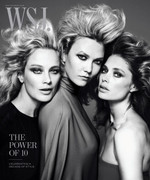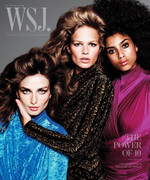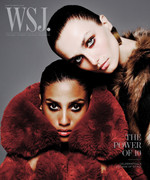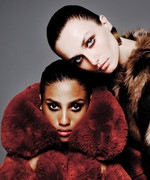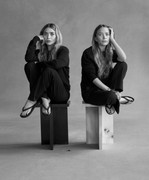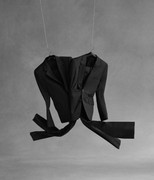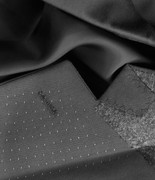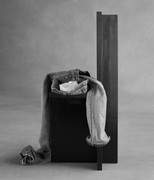Now 32, the Olsens are still sensitive about references to their childhood career, and also to suggestions that as twins they are interchangeable. While they work together closely, their adult lives are emphatically independent. Ashley, who once expected to become an architect, is considering a move back to Los Angeles from New York. Mary-Kate, who in 2015 married Sarkozy, a French banker and the half-brother of former French president Nicolas Sarkozy, says she is firmly ensconced in New York.
Still, the sisters, who have two siblings and two half-siblings, often appear to think in unison, completing each other’s sentences. “It’s been 32 years of learning how to communicate,” says Ashley, who says their relationship is “a marriage and a partnership. We have had ups and downs.”
The Olsens say their early experiences with costumes as actors helped to spur their obsession with clothing details. “Our whole lives we spent most of our time in fittings,” says Mary-Kate. “Because we’re so petite, we had to cut clothes to our size.”
With zero formal training, they began their fashion careers in 2005 in pursuit of the perfect T-shirt, which they sold at Barneys New York a year later. They researched local factories in Los Angeles and made their first pieces at a lingerie factory where the workers, accustomed to fragile materials, were able to execute tiny seams on their ultralight cotton. They later launched Elizabeth and James, a midprice fashion line that still sells today.
The Row is a sophisticated evolution of that original tee, one they say has a calculated appeal to the tastes and shapes of women over age 40, an unusual strategy for a label with young designers. And it turned out to be a sleeper hit, picking up retailers including Barneys, Saks Fifth Avenue, Net-a-Porter and Bergdorf Goodman, as well as opening its own boutiques on East 71st Street in New York and on L.A.’s Melrose Place. Fashion editors who had anticipated another Hollywood star branding effort found instead well-designed and deeply luxurious collections, one after another. Awards followed, including the CFDA’s prestigious Womenswear Designer of the Year in 2012. This past June, the evening before they were arranging the new menswear in their Greenwich Street showroom, the Olsens accepted the CFDA Accessory Designer of the Year Award.
The brand is privately owned by the sisters and is largely self-financed. “We have a very small investor, but it’s not a fashion investor,” says Ashley. The brand won’t reveal its annual revenues, but one industry insider estimates they are respectable but relatively small.
Decisions in the Olsen universe are parsed and discussed until agreement is reached. “We do everything together,” Ashley says. “We came out of the womb doing that,” says Mary-Kate.
For six months they debated where to place the two handles of the roomy unisex Margaux bag. Should the handles be attached inside, for a more classic look, or outside, for a minimalist, modern take? The office was polled. The results came in 50-50. So the Margaux was produced both ways. For men, they are also introducing a small number of thin wallets, card carriers and belts, as well as leather-soled shoes.
Criticism of The Row almost universally revolves around its prices, which rival luxe European brands such as Céline and Bottega Veneta. “We have clients that understand it and then other clients that think that our product is more expensive than it is,” says Mary-Kate. “People focus on the hype. But actually—”
“We are competitively priced,” Ashley says.
Retailers say the prices aren’t deterring clients, and the evidence backs them up. It’s unusual for a 21st-century fashion brand to make its revenues primarily from a large assortment of clothes, rather than from leather goods and accessories, yet the brand does, putting it in rare company.
‘We never started the company with the intention of it being a fashion brand.’
—Ashley Olsen
Jennifer Sunwoo, chief merchandising officer for Barneys New York, counts The Row among Barneys’ three top-selling ready-to-wear brands. “The performance has been incredibly strong, delivering consistent growth with extremely high sell-throughs,” says Sunwoo, who expects similar performance eventually from the brand’s menswear, saying that it stands out from “today’s prevailing influence of fast-fashion.”
This has come without the social-media and influence marketing that is now standard. The label’s Instagram account, with one million followers, rarely posts photos of its own products. Instead there are the designers’ inspirations—an art piece by Georges Jouve, a flatware service by Pierre Legrain or a photo of Jean Cocteau. “I think the clothes speak for themselves, and so to put a face or a name with the product doesn’t ever feel right,” says Mary-Kate.
“We’re not product pushers,” Ashley says, adding, “I don’t know if it’s because of the way we grew up—we just don’t like talking about ourselves or talking about what we’re doing.... It’s not really our approach.”
The Row’s own stores break with tradition by selling furnishings, artwork and even vintage jewelry. Some of the furniture is discovered for the brand by the Paris-based dealer Patrick Seguin. The label debuted its menswear in Seguin’s 11th arrondissement gallery along with an exhibit of furniture by Jean Prouvé, Le Corbusier and Charlotte Perriand. “The Row exudes real appreciation for an overall aesthetic, ranging from clothing to art to design,” Seguin wrote by email. “They have a minimalist approach that prioritizes quality materials.”
The Olsens can be hard to persuade using pure profit potential as a motive. Pete Nordstrom, co-president of Nordstrom, says he has been trying to bring the brand to his family’s stores for several years but the Olsens haven’t been swayed by the revenue potential of a large store chain. “They don’t approach the business like others do, caring about growth,” Nordstrom says.
The Olsens are also proud tech skeptics. The Row’s website currently directs potential shoppers to the brand’s two stores, offering no prices and no online sales. But Ashley says, to Mary-Kate’s consternation, that they are hoping to launch digital sales in 2019.
The Olsens agree that growth, in itself, isn’t the goal. “We never started the company with the intention of it being a fashion brand,” says Ashley. “It really was a passion project,” says Mary-Kate.
They say they are considering a launch of skin-care products, small leather goods such as wallets for women and more than one store in Europe.
In the meantime, they prefer to continue as they began, taking time to ponder ideas, make a few samples, test factories and ponder some more before launching anything new. “It’s not like one day we wake up and say, We’re going to grow this business, and we’re going to have a menswear collection,” says Mary-Kate. “That’s not the way we look at it.”
“Let’s not put a deadline on it,” says Ashley.
“Let’s make it perfect before we offer it,” adds Mary-Kate.


